Crisis Intervention Report: Women Losing Custody and Hybrid Model
VerifiedAdded on 2019/09/25
|6
|2534
|415
Report
AI Summary
This report delves into the concept of crisis intervention, defining it as emergency psychological care aimed at restoring equilibrium during times of intense trouble. It introduces the hybrid model, a flexible approach used to stabilize crisis situations, contrasting it with the UK's 'hazardous event' and China's 'opportunity and danger' perspectives. The report then explores the characteristics of a crisis, such as its unexpected nature and the uncertainty it creates, and outlines the seven tasks of the hybrid model: predispositioning/engaging, problem exploration, providing support, examining alternatives, planning to re-establish control, obtaining commitment, and follow-up. The application of this model is illustrated through a case study of a woman losing child custody, showcasing how each task of the hybrid model is applied. The report also highlights the importance of listening skills, such as active listening, emotional labeling, paraphrasing, effective pauses, and open-ended questions. Finally, it discusses the challenges faced by the woman and suggests ways for counselors to motivate and support her, concluding that the hybrid model is beneficial in identifying client needs and providing emotional support.
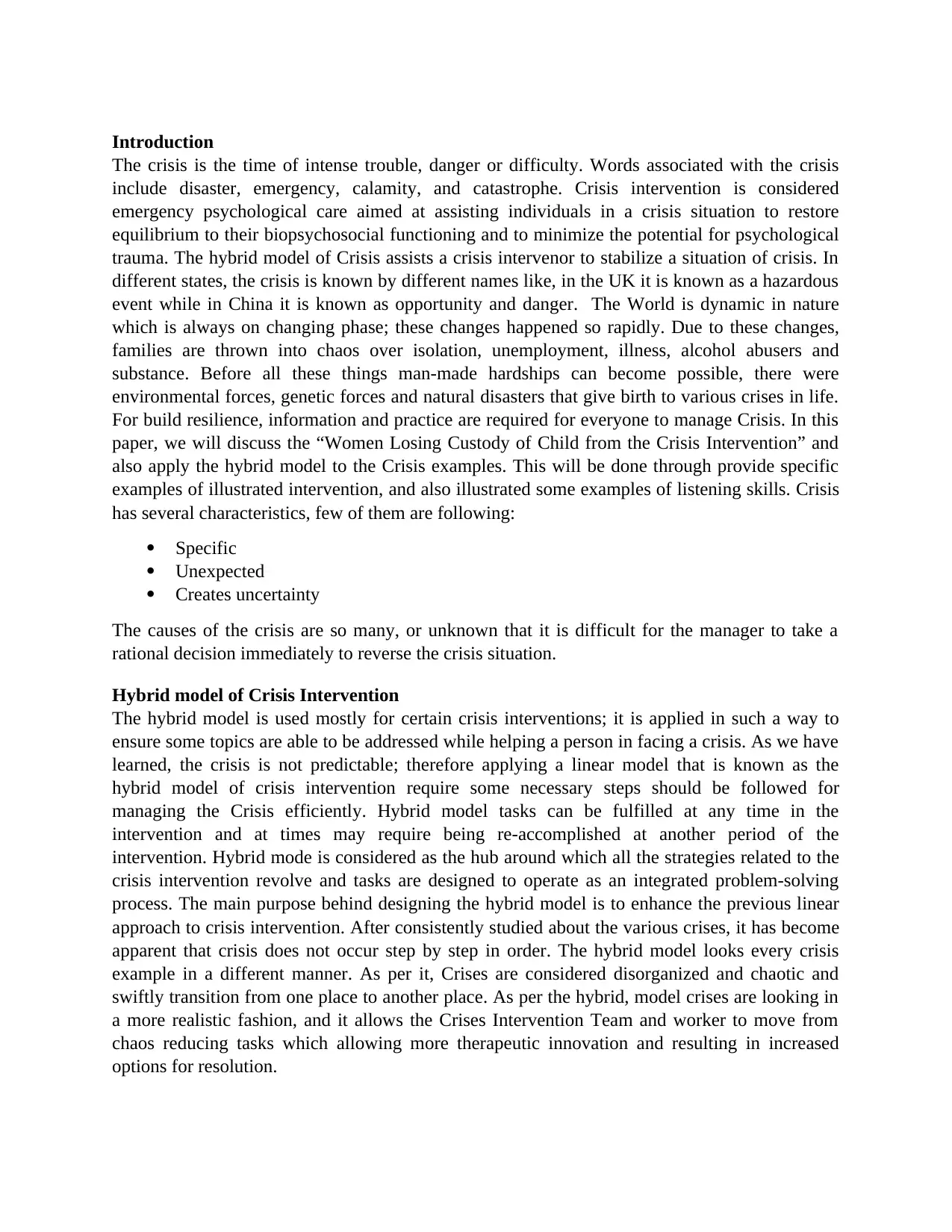
Introduction
The crisis is the time of intense trouble, danger or difficulty. Words associated with the crisis
include disaster, emergency, calamity, and catastrophe. Crisis intervention is considered
emergency psychological care aimed at assisting individuals in a crisis situation to restore
equilibrium to their biopsychosocial functioning and to minimize the potential for psychological
trauma. The hybrid model of Crisis assists a crisis intervenor to stabilize a situation of crisis. In
different states, the crisis is known by different names like, in the UK it is known as a hazardous
event while in China it is known as opportunity and danger. The World is dynamic in nature
which is always on changing phase; these changes happened so rapidly. Due to these changes,
families are thrown into chaos over isolation, unemployment, illness, alcohol abusers and
substance. Before all these things man-made hardships can become possible, there were
environmental forces, genetic forces and natural disasters that give birth to various crises in life.
For build resilience, information and practice are required for everyone to manage Crisis. In this
paper, we will discuss the “Women Losing Custody of Child from the Crisis Intervention” and
also apply the hybrid model to the Crisis examples. This will be done through provide specific
examples of illustrated intervention, and also illustrated some examples of listening skills. Crisis
has several characteristics, few of them are following:
Specific
Unexpected
Creates uncertainty
The causes of the crisis are so many, or unknown that it is difficult for the manager to take a
rational decision immediately to reverse the crisis situation.
Hybrid model of Crisis Intervention
The hybrid model is used mostly for certain crisis interventions; it is applied in such a way to
ensure some topics are able to be addressed while helping a person in facing a crisis. As we have
learned, the crisis is not predictable; therefore applying a linear model that is known as the
hybrid model of crisis intervention require some necessary steps should be followed for
managing the Crisis efficiently. Hybrid model tasks can be fulfilled at any time in the
intervention and at times may require being re-accomplished at another period of the
intervention. Hybrid mode is considered as the hub around which all the strategies related to the
crisis intervention revolve and tasks are designed to operate as an integrated problem-solving
process. The main purpose behind designing the hybrid model is to enhance the previous linear
approach to crisis intervention. After consistently studied about the various crises, it has become
apparent that crisis does not occur step by step in order. The hybrid model looks every crisis
example in a different manner. As per it, Crises are considered disorganized and chaotic and
swiftly transition from one place to another place. As per the hybrid, model crises are looking in
a more realistic fashion, and it allows the Crises Intervention Team and worker to move from
chaos reducing tasks which allowing more therapeutic innovation and resulting in increased
options for resolution.
The crisis is the time of intense trouble, danger or difficulty. Words associated with the crisis
include disaster, emergency, calamity, and catastrophe. Crisis intervention is considered
emergency psychological care aimed at assisting individuals in a crisis situation to restore
equilibrium to their biopsychosocial functioning and to minimize the potential for psychological
trauma. The hybrid model of Crisis assists a crisis intervenor to stabilize a situation of crisis. In
different states, the crisis is known by different names like, in the UK it is known as a hazardous
event while in China it is known as opportunity and danger. The World is dynamic in nature
which is always on changing phase; these changes happened so rapidly. Due to these changes,
families are thrown into chaos over isolation, unemployment, illness, alcohol abusers and
substance. Before all these things man-made hardships can become possible, there were
environmental forces, genetic forces and natural disasters that give birth to various crises in life.
For build resilience, information and practice are required for everyone to manage Crisis. In this
paper, we will discuss the “Women Losing Custody of Child from the Crisis Intervention” and
also apply the hybrid model to the Crisis examples. This will be done through provide specific
examples of illustrated intervention, and also illustrated some examples of listening skills. Crisis
has several characteristics, few of them are following:
Specific
Unexpected
Creates uncertainty
The causes of the crisis are so many, or unknown that it is difficult for the manager to take a
rational decision immediately to reverse the crisis situation.
Hybrid model of Crisis Intervention
The hybrid model is used mostly for certain crisis interventions; it is applied in such a way to
ensure some topics are able to be addressed while helping a person in facing a crisis. As we have
learned, the crisis is not predictable; therefore applying a linear model that is known as the
hybrid model of crisis intervention require some necessary steps should be followed for
managing the Crisis efficiently. Hybrid model tasks can be fulfilled at any time in the
intervention and at times may require being re-accomplished at another period of the
intervention. Hybrid mode is considered as the hub around which all the strategies related to the
crisis intervention revolve and tasks are designed to operate as an integrated problem-solving
process. The main purpose behind designing the hybrid model is to enhance the previous linear
approach to crisis intervention. After consistently studied about the various crises, it has become
apparent that crisis does not occur step by step in order. The hybrid model looks every crisis
example in a different manner. As per it, Crises are considered disorganized and chaotic and
swiftly transition from one place to another place. As per the hybrid, model crises are looking in
a more realistic fashion, and it allows the Crises Intervention Team and worker to move from
chaos reducing tasks which allowing more therapeutic innovation and resulting in increased
options for resolution.
Paraphrase This Document
Need a fresh take? Get an instant paraphrase of this document with our AI Paraphraser
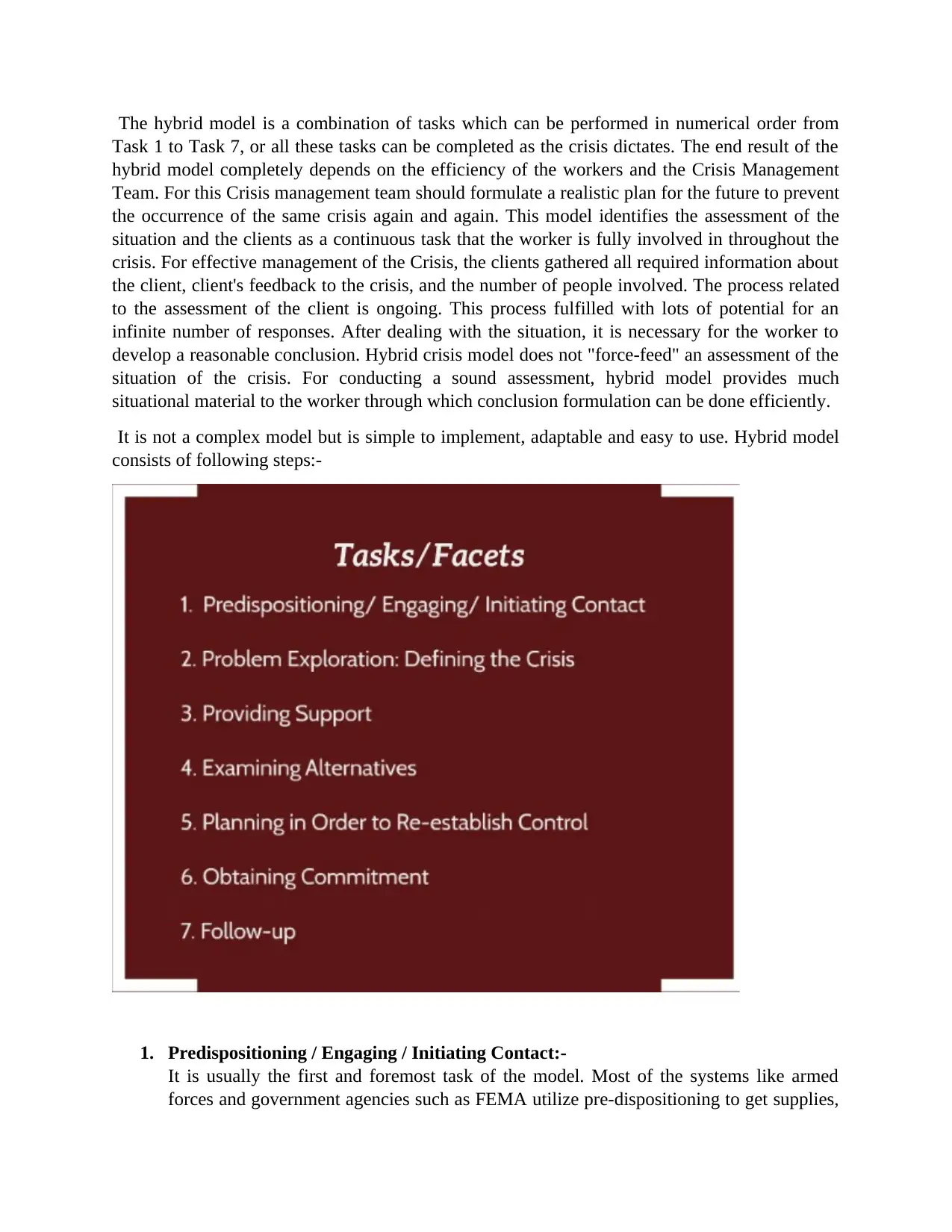
The hybrid model is a combination of tasks which can be performed in numerical order from
Task 1 to Task 7, or all these tasks can be completed as the crisis dictates. The end result of the
hybrid model completely depends on the efficiency of the workers and the Crisis Management
Team. For this Crisis management team should formulate a realistic plan for the future to prevent
the occurrence of the same crisis again and again. This model identifies the assessment of the
situation and the clients as a continuous task that the worker is fully involved in throughout the
crisis. For effective management of the Crisis, the clients gathered all required information about
the client, client's feedback to the crisis, and the number of people involved. The process related
to the assessment of the client is ongoing. This process fulfilled with lots of potential for an
infinite number of responses. After dealing with the situation, it is necessary for the worker to
develop a reasonable conclusion. Hybrid crisis model does not "force-feed" an assessment of the
situation of the crisis. For conducting a sound assessment, hybrid model provides much
situational material to the worker through which conclusion formulation can be done efficiently.
It is not a complex model but is simple to implement, adaptable and easy to use. Hybrid model
consists of following steps:-
1. Predispositioning / Engaging / Initiating Contact:-
It is usually the first and foremost task of the model. Most of the systems like armed
forces and government agencies such as FEMA utilize pre-dispositioning to get supplies,
Task 1 to Task 7, or all these tasks can be completed as the crisis dictates. The end result of the
hybrid model completely depends on the efficiency of the workers and the Crisis Management
Team. For this Crisis management team should formulate a realistic plan for the future to prevent
the occurrence of the same crisis again and again. This model identifies the assessment of the
situation and the clients as a continuous task that the worker is fully involved in throughout the
crisis. For effective management of the Crisis, the clients gathered all required information about
the client, client's feedback to the crisis, and the number of people involved. The process related
to the assessment of the client is ongoing. This process fulfilled with lots of potential for an
infinite number of responses. After dealing with the situation, it is necessary for the worker to
develop a reasonable conclusion. Hybrid crisis model does not "force-feed" an assessment of the
situation of the crisis. For conducting a sound assessment, hybrid model provides much
situational material to the worker through which conclusion formulation can be done efficiently.
It is not a complex model but is simple to implement, adaptable and easy to use. Hybrid model
consists of following steps:-
1. Predispositioning / Engaging / Initiating Contact:-
It is usually the first and foremost task of the model. Most of the systems like armed
forces and government agencies such as FEMA utilize pre-dispositioning to get supplies,
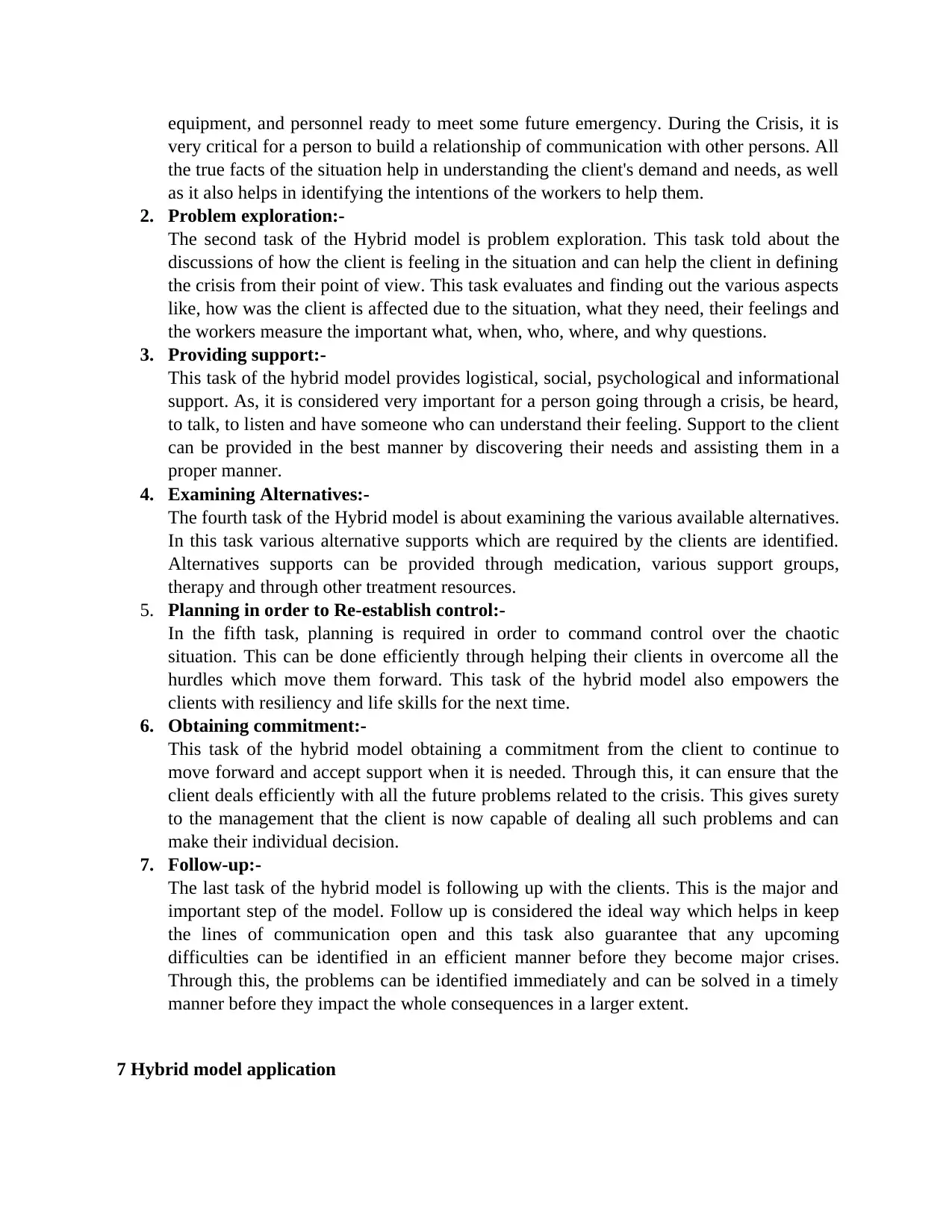
equipment, and personnel ready to meet some future emergency. During the Crisis, it is
very critical for a person to build a relationship of communication with other persons. All
the true facts of the situation help in understanding the client's demand and needs, as well
as it also helps in identifying the intentions of the workers to help them.
2. Problem exploration:-
The second task of the Hybrid model is problem exploration. This task told about the
discussions of how the client is feeling in the situation and can help the client in defining
the crisis from their point of view. This task evaluates and finding out the various aspects
like, how was the client is affected due to the situation, what they need, their feelings and
the workers measure the important what, when, who, where, and why questions.
3. Providing support:-
This task of the hybrid model provides logistical, social, psychological and informational
support. As, it is considered very important for a person going through a crisis, be heard,
to talk, to listen and have someone who can understand their feeling. Support to the client
can be provided in the best manner by discovering their needs and assisting them in a
proper manner.
4. Examining Alternatives:-
The fourth task of the Hybrid model is about examining the various available alternatives.
In this task various alternative supports which are required by the clients are identified.
Alternatives supports can be provided through medication, various support groups,
therapy and through other treatment resources.
5. Planning in order to Re-establish control:-
In the fifth task, planning is required in order to command control over the chaotic
situation. This can be done efficiently through helping their clients in overcome all the
hurdles which move them forward. This task of the hybrid model also empowers the
clients with resiliency and life skills for the next time.
6. Obtaining commitment:-
This task of the hybrid model obtaining a commitment from the client to continue to
move forward and accept support when it is needed. Through this, it can ensure that the
client deals efficiently with all the future problems related to the crisis. This gives surety
to the management that the client is now capable of dealing all such problems and can
make their individual decision.
7. Follow-up:-
The last task of the hybrid model is following up with the clients. This is the major and
important step of the model. Follow up is considered the ideal way which helps in keep
the lines of communication open and this task also guarantee that any upcoming
difficulties can be identified in an efficient manner before they become major crises.
Through this, the problems can be identified immediately and can be solved in a timely
manner before they impact the whole consequences in a larger extent.
7 Hybrid model application
very critical for a person to build a relationship of communication with other persons. All
the true facts of the situation help in understanding the client's demand and needs, as well
as it also helps in identifying the intentions of the workers to help them.
2. Problem exploration:-
The second task of the Hybrid model is problem exploration. This task told about the
discussions of how the client is feeling in the situation and can help the client in defining
the crisis from their point of view. This task evaluates and finding out the various aspects
like, how was the client is affected due to the situation, what they need, their feelings and
the workers measure the important what, when, who, where, and why questions.
3. Providing support:-
This task of the hybrid model provides logistical, social, psychological and informational
support. As, it is considered very important for a person going through a crisis, be heard,
to talk, to listen and have someone who can understand their feeling. Support to the client
can be provided in the best manner by discovering their needs and assisting them in a
proper manner.
4. Examining Alternatives:-
The fourth task of the Hybrid model is about examining the various available alternatives.
In this task various alternative supports which are required by the clients are identified.
Alternatives supports can be provided through medication, various support groups,
therapy and through other treatment resources.
5. Planning in order to Re-establish control:-
In the fifth task, planning is required in order to command control over the chaotic
situation. This can be done efficiently through helping their clients in overcome all the
hurdles which move them forward. This task of the hybrid model also empowers the
clients with resiliency and life skills for the next time.
6. Obtaining commitment:-
This task of the hybrid model obtaining a commitment from the client to continue to
move forward and accept support when it is needed. Through this, it can ensure that the
client deals efficiently with all the future problems related to the crisis. This gives surety
to the management that the client is now capable of dealing all such problems and can
make their individual decision.
7. Follow-up:-
The last task of the hybrid model is following up with the clients. This is the major and
important step of the model. Follow up is considered the ideal way which helps in keep
the lines of communication open and this task also guarantee that any upcoming
difficulties can be identified in an efficient manner before they become major crises.
Through this, the problems can be identified immediately and can be solved in a timely
manner before they impact the whole consequences in a larger extent.
7 Hybrid model application
⊘ This is a preview!⊘
Do you want full access?
Subscribe today to unlock all pages.

Trusted by 1+ million students worldwide
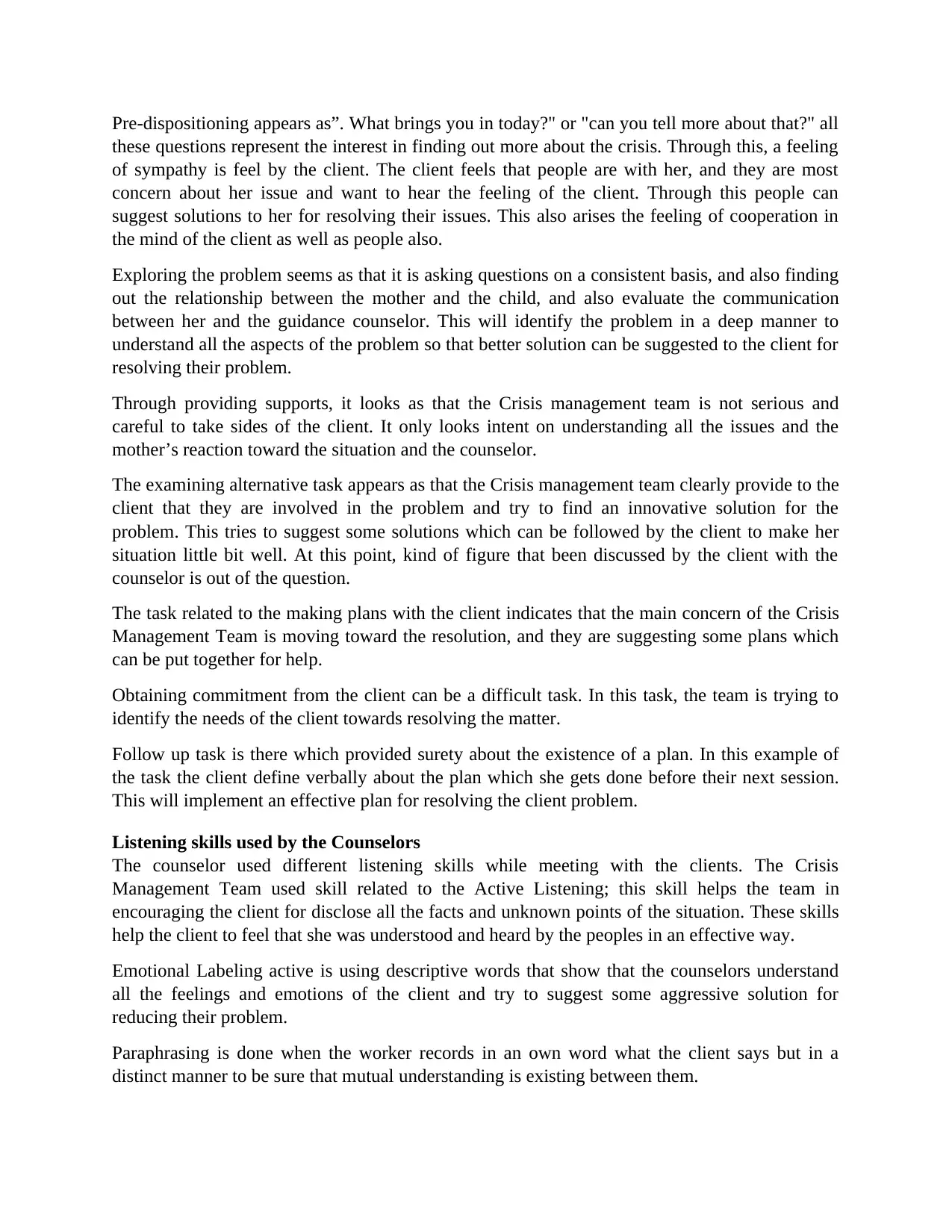
Pre-dispositioning appears as”. What brings you in today?" or "can you tell more about that?" all
these questions represent the interest in finding out more about the crisis. Through this, a feeling
of sympathy is feel by the client. The client feels that people are with her, and they are most
concern about her issue and want to hear the feeling of the client. Through this people can
suggest solutions to her for resolving their issues. This also arises the feeling of cooperation in
the mind of the client as well as people also.
Exploring the problem seems as that it is asking questions on a consistent basis, and also finding
out the relationship between the mother and the child, and also evaluate the communication
between her and the guidance counselor. This will identify the problem in a deep manner to
understand all the aspects of the problem so that better solution can be suggested to the client for
resolving their problem.
Through providing supports, it looks as that the Crisis management team is not serious and
careful to take sides of the client. It only looks intent on understanding all the issues and the
mother’s reaction toward the situation and the counselor.
The examining alternative task appears as that the Crisis management team clearly provide to the
client that they are involved in the problem and try to find an innovative solution for the
problem. This tries to suggest some solutions which can be followed by the client to make her
situation little bit well. At this point, kind of figure that been discussed by the client with the
counselor is out of the question.
The task related to the making plans with the client indicates that the main concern of the Crisis
Management Team is moving toward the resolution, and they are suggesting some plans which
can be put together for help.
Obtaining commitment from the client can be a difficult task. In this task, the team is trying to
identify the needs of the client towards resolving the matter.
Follow up task is there which provided surety about the existence of a plan. In this example of
the task the client define verbally about the plan which she gets done before their next session.
This will implement an effective plan for resolving the client problem.
Listening skills used by the Counselors
The counselor used different listening skills while meeting with the clients. The Crisis
Management Team used skill related to the Active Listening; this skill helps the team in
encouraging the client for disclose all the facts and unknown points of the situation. These skills
help the client to feel that she was understood and heard by the peoples in an effective way.
Emotional Labeling active is using descriptive words that show that the counselors understand
all the feelings and emotions of the client and try to suggest some aggressive solution for
reducing their problem.
Paraphrasing is done when the worker records in an own word what the client says but in a
distinct manner to be sure that mutual understanding is existing between them.
these questions represent the interest in finding out more about the crisis. Through this, a feeling
of sympathy is feel by the client. The client feels that people are with her, and they are most
concern about her issue and want to hear the feeling of the client. Through this people can
suggest solutions to her for resolving their issues. This also arises the feeling of cooperation in
the mind of the client as well as people also.
Exploring the problem seems as that it is asking questions on a consistent basis, and also finding
out the relationship between the mother and the child, and also evaluate the communication
between her and the guidance counselor. This will identify the problem in a deep manner to
understand all the aspects of the problem so that better solution can be suggested to the client for
resolving their problem.
Through providing supports, it looks as that the Crisis management team is not serious and
careful to take sides of the client. It only looks intent on understanding all the issues and the
mother’s reaction toward the situation and the counselor.
The examining alternative task appears as that the Crisis management team clearly provide to the
client that they are involved in the problem and try to find an innovative solution for the
problem. This tries to suggest some solutions which can be followed by the client to make her
situation little bit well. At this point, kind of figure that been discussed by the client with the
counselor is out of the question.
The task related to the making plans with the client indicates that the main concern of the Crisis
Management Team is moving toward the resolution, and they are suggesting some plans which
can be put together for help.
Obtaining commitment from the client can be a difficult task. In this task, the team is trying to
identify the needs of the client towards resolving the matter.
Follow up task is there which provided surety about the existence of a plan. In this example of
the task the client define verbally about the plan which she gets done before their next session.
This will implement an effective plan for resolving the client problem.
Listening skills used by the Counselors
The counselor used different listening skills while meeting with the clients. The Crisis
Management Team used skill related to the Active Listening; this skill helps the team in
encouraging the client for disclose all the facts and unknown points of the situation. These skills
help the client to feel that she was understood and heard by the peoples in an effective way.
Emotional Labeling active is using descriptive words that show that the counselors understand
all the feelings and emotions of the client and try to suggest some aggressive solution for
reducing their problem.
Paraphrasing is done when the worker records in an own word what the client says but in a
distinct manner to be sure that mutual understanding is existing between them.
Paraphrase This Document
Need a fresh take? Get an instant paraphrase of this document with our AI Paraphraser
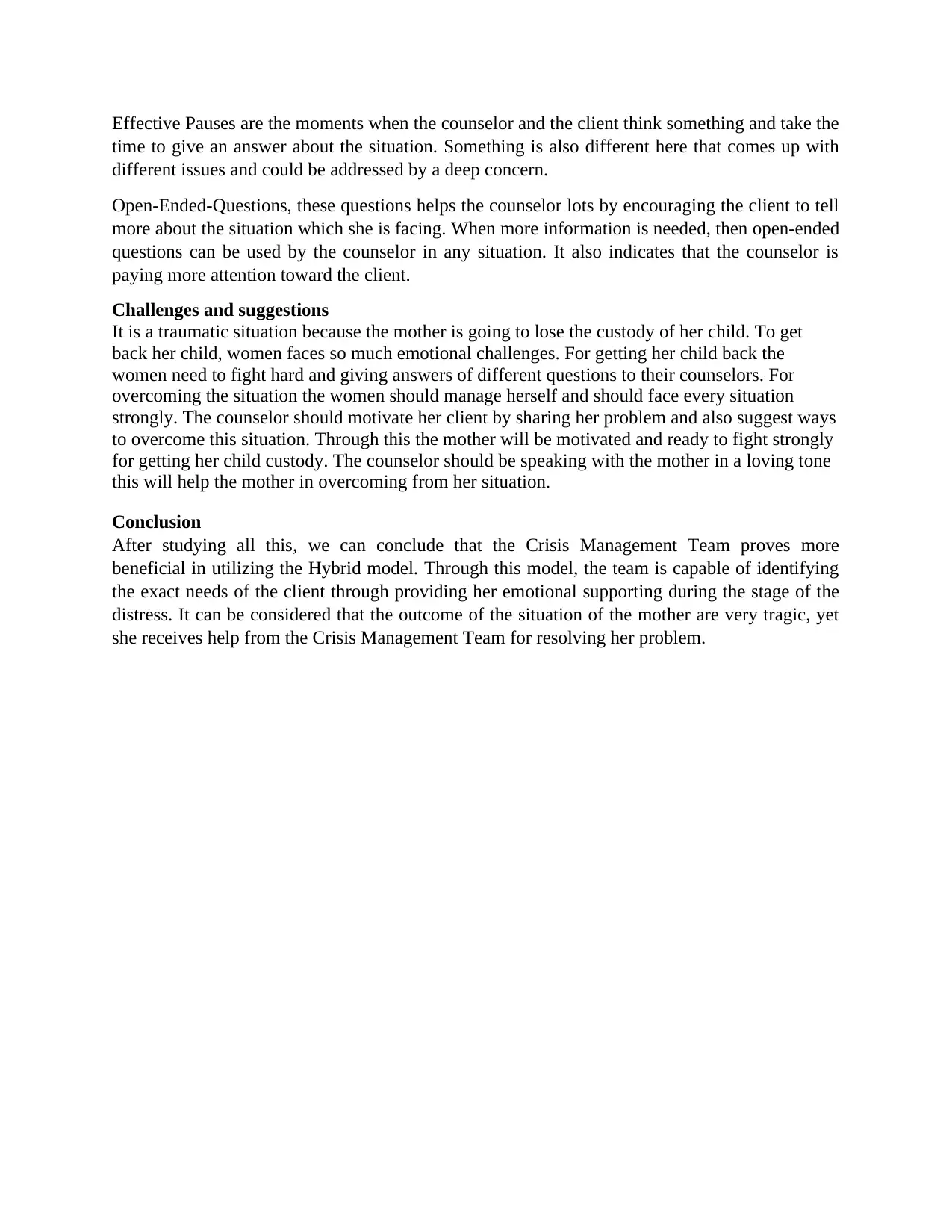
Effective Pauses are the moments when the counselor and the client think something and take the
time to give an answer about the situation. Something is also different here that comes up with
different issues and could be addressed by a deep concern.
Open-Ended-Questions, these questions helps the counselor lots by encouraging the client to tell
more about the situation which she is facing. When more information is needed, then open-ended
questions can be used by the counselor in any situation. It also indicates that the counselor is
paying more attention toward the client.
Challenges and suggestions
It is a traumatic situation because the mother is going to lose the custody of her child. To get
back her child, women faces so much emotional challenges. For getting her child back the
women need to fight hard and giving answers of different questions to their counselors. For
overcoming the situation the women should manage herself and should face every situation
strongly. The counselor should motivate her client by sharing her problem and also suggest ways
to overcome this situation. Through this the mother will be motivated and ready to fight strongly
for getting her child custody. The counselor should be speaking with the mother in a loving tone
this will help the mother in overcoming from her situation.
Conclusion
After studying all this, we can conclude that the Crisis Management Team proves more
beneficial in utilizing the Hybrid model. Through this model, the team is capable of identifying
the exact needs of the client through providing her emotional supporting during the stage of the
distress. It can be considered that the outcome of the situation of the mother are very tragic, yet
she receives help from the Crisis Management Team for resolving her problem.
time to give an answer about the situation. Something is also different here that comes up with
different issues and could be addressed by a deep concern.
Open-Ended-Questions, these questions helps the counselor lots by encouraging the client to tell
more about the situation which she is facing. When more information is needed, then open-ended
questions can be used by the counselor in any situation. It also indicates that the counselor is
paying more attention toward the client.
Challenges and suggestions
It is a traumatic situation because the mother is going to lose the custody of her child. To get
back her child, women faces so much emotional challenges. For getting her child back the
women need to fight hard and giving answers of different questions to their counselors. For
overcoming the situation the women should manage herself and should face every situation
strongly. The counselor should motivate her client by sharing her problem and also suggest ways
to overcome this situation. Through this the mother will be motivated and ready to fight strongly
for getting her child custody. The counselor should be speaking with the mother in a loving tone
this will help the mother in overcoming from her situation.
Conclusion
After studying all this, we can conclude that the Crisis Management Team proves more
beneficial in utilizing the Hybrid model. Through this model, the team is capable of identifying
the exact needs of the client through providing her emotional supporting during the stage of the
distress. It can be considered that the outcome of the situation of the mother are very tragic, yet
she receives help from the Crisis Management Team for resolving her problem.
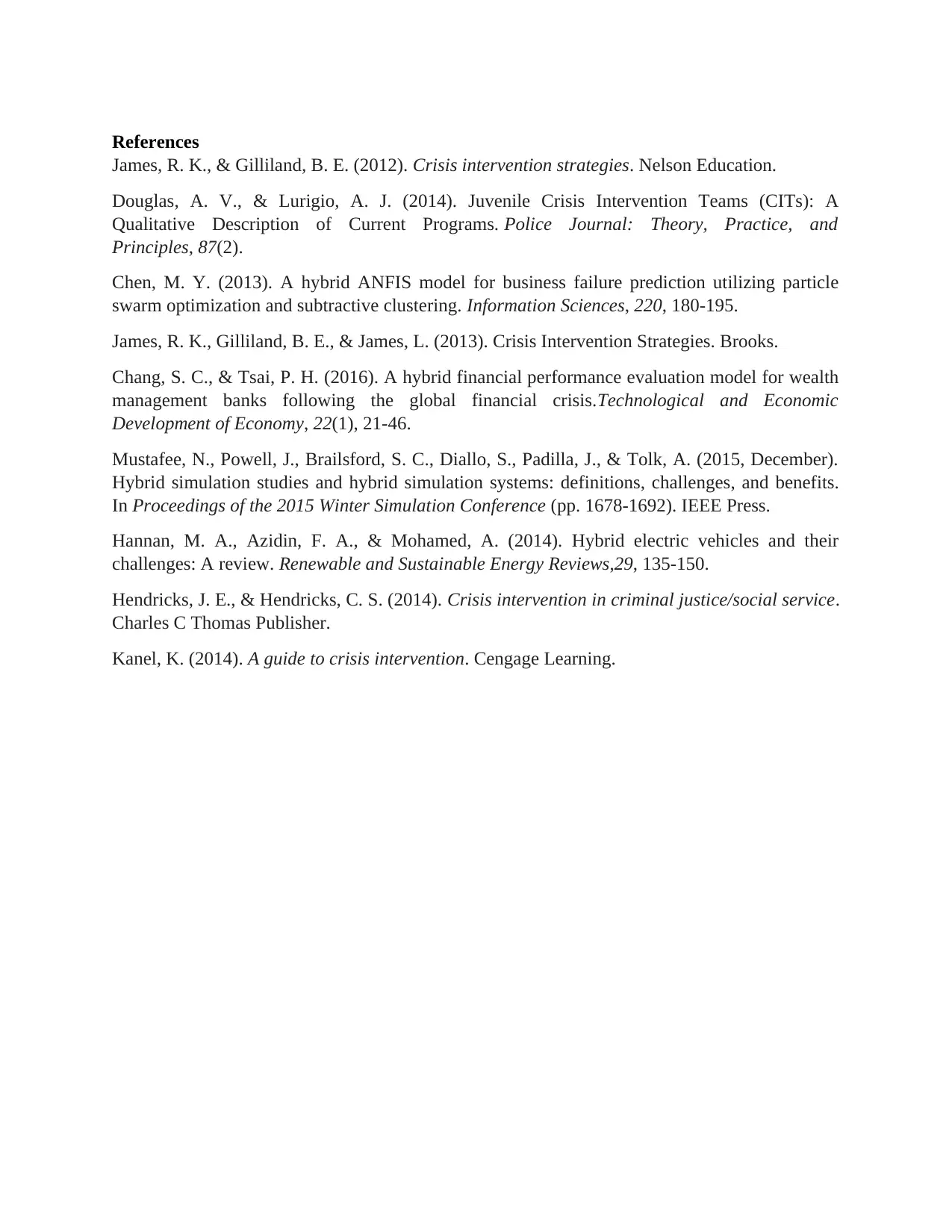
References
James, R. K., & Gilliland, B. E. (2012). Crisis intervention strategies. Nelson Education.
Douglas, A. V., & Lurigio, A. J. (2014). Juvenile Crisis Intervention Teams (CITs): A
Qualitative Description of Current Programs. Police Journal: Theory, Practice, and
Principles, 87(2).
Chen, M. Y. (2013). A hybrid ANFIS model for business failure prediction utilizing particle
swarm optimization and subtractive clustering. Information Sciences, 220, 180-195.
James, R. K., Gilliland, B. E., & James, L. (2013). Crisis Intervention Strategies. Brooks.
Chang, S. C., & Tsai, P. H. (2016). A hybrid financial performance evaluation model for wealth
management banks following the global financial crisis.Technological and Economic
Development of Economy, 22(1), 21-46.
Mustafee, N., Powell, J., Brailsford, S. C., Diallo, S., Padilla, J., & Tolk, A. (2015, December).
Hybrid simulation studies and hybrid simulation systems: definitions, challenges, and benefits.
In Proceedings of the 2015 Winter Simulation Conference (pp. 1678-1692). IEEE Press.
Hannan, M. A., Azidin, F. A., & Mohamed, A. (2014). Hybrid electric vehicles and their
challenges: A review. Renewable and Sustainable Energy Reviews,29, 135-150.
Hendricks, J. E., & Hendricks, C. S. (2014). Crisis intervention in criminal justice/social service.
Charles C Thomas Publisher.
Kanel, K. (2014). A guide to crisis intervention. Cengage Learning.
James, R. K., & Gilliland, B. E. (2012). Crisis intervention strategies. Nelson Education.
Douglas, A. V., & Lurigio, A. J. (2014). Juvenile Crisis Intervention Teams (CITs): A
Qualitative Description of Current Programs. Police Journal: Theory, Practice, and
Principles, 87(2).
Chen, M. Y. (2013). A hybrid ANFIS model for business failure prediction utilizing particle
swarm optimization and subtractive clustering. Information Sciences, 220, 180-195.
James, R. K., Gilliland, B. E., & James, L. (2013). Crisis Intervention Strategies. Brooks.
Chang, S. C., & Tsai, P. H. (2016). A hybrid financial performance evaluation model for wealth
management banks following the global financial crisis.Technological and Economic
Development of Economy, 22(1), 21-46.
Mustafee, N., Powell, J., Brailsford, S. C., Diallo, S., Padilla, J., & Tolk, A. (2015, December).
Hybrid simulation studies and hybrid simulation systems: definitions, challenges, and benefits.
In Proceedings of the 2015 Winter Simulation Conference (pp. 1678-1692). IEEE Press.
Hannan, M. A., Azidin, F. A., & Mohamed, A. (2014). Hybrid electric vehicles and their
challenges: A review. Renewable and Sustainable Energy Reviews,29, 135-150.
Hendricks, J. E., & Hendricks, C. S. (2014). Crisis intervention in criminal justice/social service.
Charles C Thomas Publisher.
Kanel, K. (2014). A guide to crisis intervention. Cengage Learning.
⊘ This is a preview!⊘
Do you want full access?
Subscribe today to unlock all pages.

Trusted by 1+ million students worldwide
1 out of 6
Your All-in-One AI-Powered Toolkit for Academic Success.
+13062052269
info@desklib.com
Available 24*7 on WhatsApp / Email
![[object Object]](/_next/static/media/star-bottom.7253800d.svg)
Unlock your academic potential
Copyright © 2020–2025 A2Z Services. All Rights Reserved. Developed and managed by ZUCOL.

